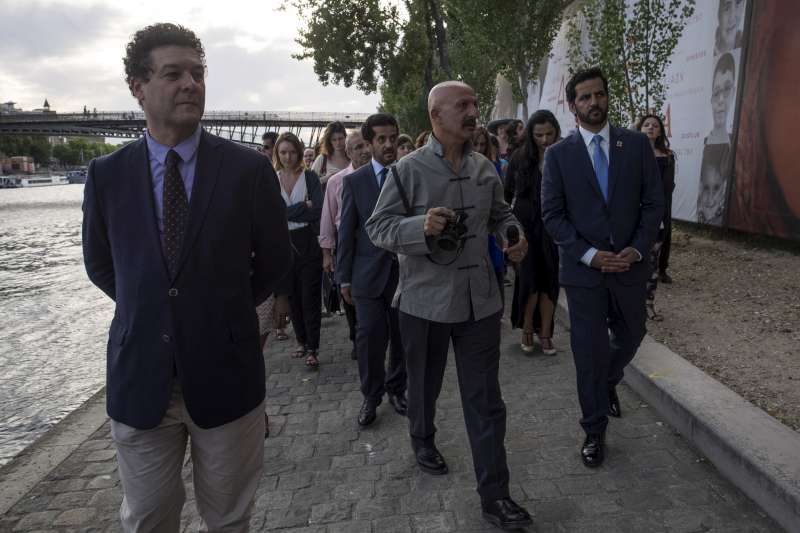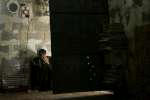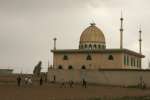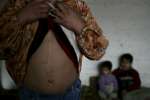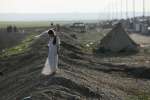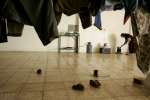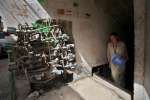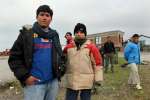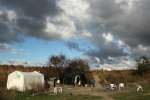Reza's "A Dream of humanity" opens on the banks of the Seine in Paris
Telling the Human Story, 5 August 2015
PARIS, Aug 5 (UNHCR) – A gigantic photo exhibition now covers the walls along the banks of the Seine in Paris. The 370-metre long panorama includes photos representing humanity and diversity as well as seven key words translated into languages from all around the world: respect, peace, solidarity, friendship, dignity, hospitality and hope.
The exhibition that UNHCR helped plan includes photos taken by the famous photojournalist Reza over the past 30 years, and portraits of refugees by photographer Ali Bin Thalith. It also features photographs taken by Syrian refugee children living in Kawergosk refugee camp in Iraq and trained in photography by the world-renowned Reza.
The exhibition is organized by Reza in partnership with UNHCR and the «Mairie de Paris» and is sponsored by the Hamdan bin Mohammed bin Rashid Al Maktoum International Photography Award (HIPA). It was officially launched on 4 August.
All over the summer and until mid-October this year, the Parisians, visitors and tourists will have the opportunity to see these photographs while walking on the banks of the Seine opposite the Orsay Museum. The first visitors were struck by the photos and what they mean to them.
"I think that France and Paris should be more open to hosting refugees. I don't know if borders should exist. It is not only the French, but it is all the nations who don't react. We should at least give them the minimum, to give them back their dignity. For example, before we had public baths that were open in Paris. Taking a shower is not once a week, it is every day. They need to be able to shower. Hygiene is important. They are human beings. We should give them back their dignity," said 63 year-old Cecile while talking to UNHCR volunteers who guide the visitors through the exhibition.
Another visitor noted the current situation in Europe and commented that the situation is still better in France than in many other European countries.
A few hundred metres further down the river the photos already turn into reality where refugees and migrants are sleeping in a makeshift settlement under a bridge on the banks just beneath the Cité de la mode.
"In the current context of the worsening situation of asylum in Europe and worsening conditions for asylum seekers and refugees, the exhibition is reminding us that 60 million people are uprooted around the world and that many of their basic needs are not covered. We hope that the exhibition will invite visitors to reflect on the situation of refugees, create awareness, empathy and actions of solidarity," said Philippe Leclerc, UNHCR's Representative in France.
For many visitors, the most stunning part of the exhibition is the section with the photos of Kawergosk refugee camp taken by Syrian refugee children. These were taken in December 2013 when Reza travelled to Kawergosk refugee camp hosting Syrian refugees in Iraq. During his mission he started a photography workshop for the children living in the camp. Some 10 children aged from 12 to 15 took part in the workshop and the result was astonishing.
"Many professional photographers, including myself are jealous of these photos. We would have loved to take photos like these," Reza explained.
This workshop was the birth of the Exile Voices project, where Reza in partnership with UNHCR will organize photo workshops for youth in refugee camps throughout the world.
"It is my pleasure and my honour that during my long photographer's career, somehow, I shared the lives of these people and invited the audience to think of refugee situations since anybody can become a refugee. I also witnessed UNHCR's work in the field and I want to pay tribute to the commitment of its staff", Reza added.
HIPA is sponsoring the exhibition "A Dream of Humanity" to be part of the wide-ranging humanitarian responsibility and to document the living conditions of refugees and their everyday struggles.
"We also feel that it is our moral obligation to raise awareness of the current plight of Syrian refugees and their bravery in telling us their stories by staring into the lens of a camera", said Ali bin Thalith, Secretary General of HIPA, who is a photographer himself.
*The exhibition is located opposite the Orsay Museum, between the Louvre Palace and the Pont Royal, until 15 October.
By Celine Schmitt, Zeinab Abouquir and Fadma Moumtaz in Paris, France





